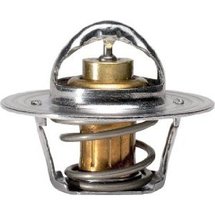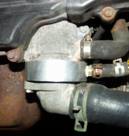Testing engine thermostats

Engine thermostats are often the cause of overheating problems. If the thermostat is stuck closed, only a trickle of coolant will flow through the radiator.
Thermostats are also the cause of many complaints of poor heater operation and can also be linked to poor automotive engine performance.
If the engine thermostat is stuck open the coolant may not reach the desired temperature because the coolant is not restricted in flow, and heat never builds up.
A properly working thermostat will be closed when the engine is cold, and the coolant has a temperature lower than the thermostats opening setting.
Once the coolant reaches the opening temperature a valve expands inside the thermostat to open it and allow increased coolant flow to the radiator. The hotter the engine coolant gets the more the valve will open.
Why the thermostat must function properly
Modern-day electronic engine control systems are very dependent on the regulation of engine coolant temperatures. A faulty engine thermostat will not only cause overheating and poor heater performance but may cause an increase in fuel consumption and lack of engine performance.
The engine management computer is programmed to deliver the ideal fuel mixture and ignition timing according to the engine’s current operating conditions. This includes the engine temperature.
Testing engine thermostats

There are several ways to test this commonly replaced auto part. If the unit is in a convenient location it is recommended that you remove it for testing. You can hang the thermostat completely submerged in a small container of water so it does not touch the bottom. Place a thermometer in the hot water bath so; it also does not touch the container bottom.
Properly testing engine thermostats will require heating the water until slight movement is noticed at the thermostat opening. As soon as any movement is detected, take a reading from the thermometer.
This will be the opening temperature of your particular unit you are testing. If you remove the thermostat from the heat, and it remains open, you have just found yourself a defective thermostat.
When the housing and retaining bolts are extremely difficult to get to some professional mechanics will use the following method for Testing engine thermostats. When the engine is completely cold and has not been run, you can remove the radiator pressure cap and insert a thermometer into the coolant.
You can then start the engine and let it warm up. Watch the thermometer and the surface of the engine coolant. When the engine coolant begins to flow this indicates that the thermostat has started to open.
The reading on the thermometer will indicate the opening temperature. If a cold engine is started and coolant flows right away and is slow to increasing temperature. Your thermostat will most likely be stuck in the open position and require replacement.

When replacing thermostats also be sure to replace the gaskets that seal the assembly inside the housing. Some do-it-yourself car mechanics may elect to skip this step and use silicone RTV. It is recommended to spend a few extra dollars and get a factory replacement gasket or seal.
Generally, these gaskets are made out of a composition fiber material and are die cut to match the thermostat opening and mounting bolt configuration of your water outlet. Sometimes these cooling system gaskets will come with an adhesive backing.
This holds the gaskets securely centered on the mounting flange, leaving both hands free to align and bolt the car part securely in place.

